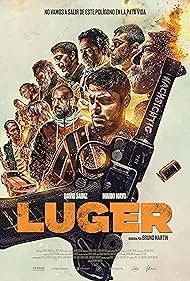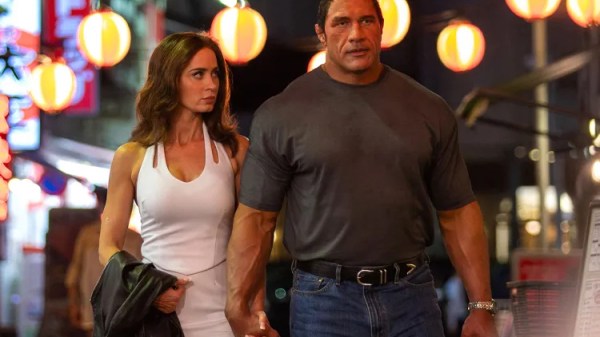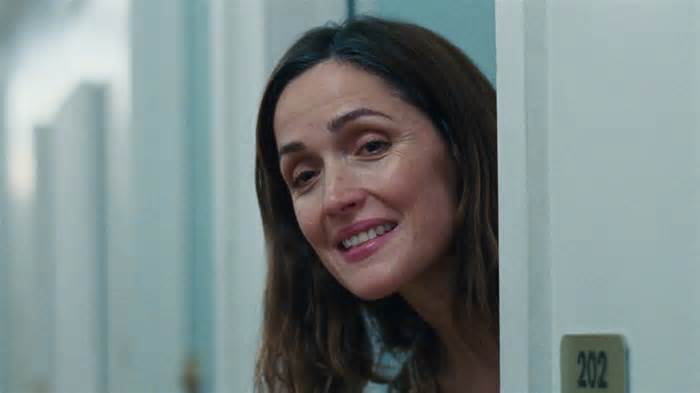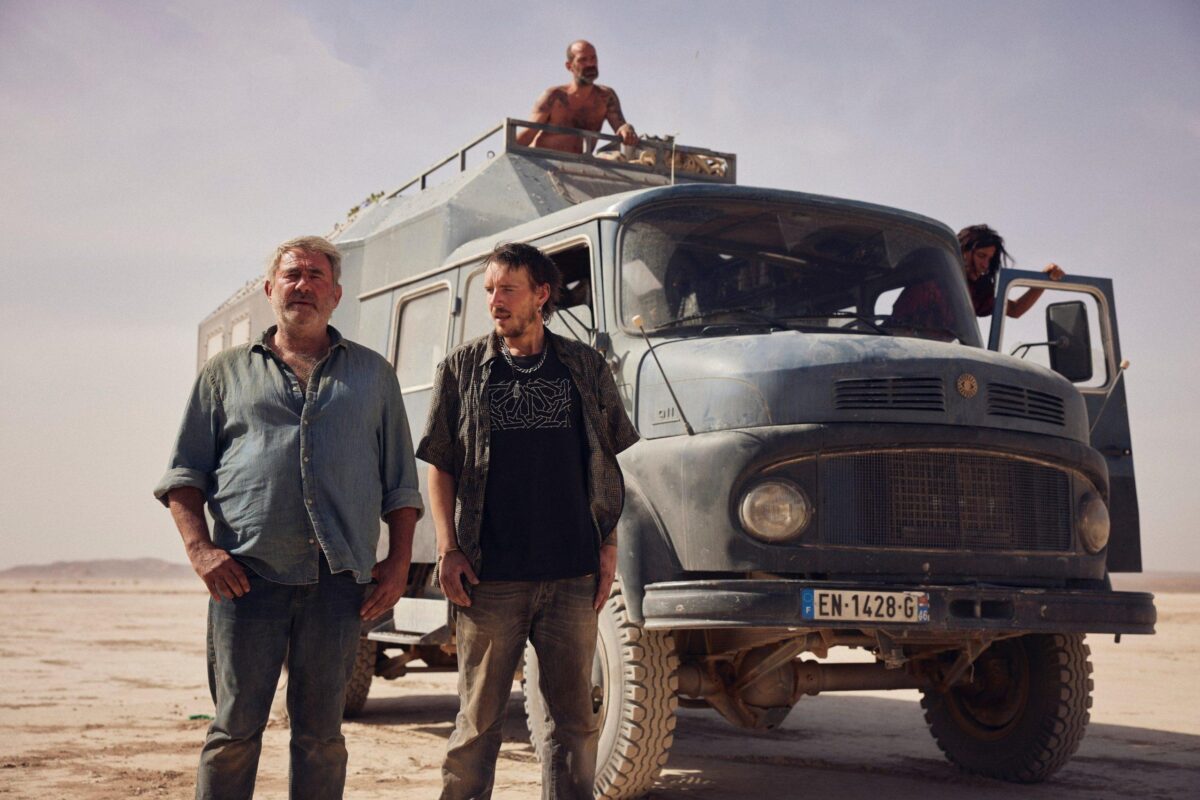
Brian: What I want to start with is a simple question; where did you get the idea for Luger?
Santiago Taboada: The first idea of making Luger was created from Bruno [Martín] and I. We just reunited in a bar and we said, “we have to make a movie.” We didn’t know what kind of movie we wanted to make, but suddenly we were developing a story about two guys in a tough environment where their friendship is the bond that unites them against everything that happens to them. That’s where everything started.
Bruno Martín: The movie is about second chances and about forgiveness. The character is looking for redemption, for a second chance of forgiveness. They find this Luger, this historical, epic element that elevates the story. It’s ironic because this Luger, it’s the past of one of the characters, the antagonist, that they are going to face that is chasing him from his grandfather. So, that’s where everything collapses and starts. The story element of the Luger is kind of epic. It’s a World War II element and it collapses and mixes with the daily life of these two thugs. Those universes collapse and they create a great universe. It’s surrounded by this aura from this World War II element.
Brian: Okay. This is also for Bruno and Santiago, what were some of your influences, like movies, directors to help you imagine Luger?
Bruno: Training Day, Antoine Fuqua, Nine Queens, Fabian Bielinsky, Crank, Neveldine/Taylor, Walter Hill, The Warriors, or Reservoir Dogs, Quentin.
Brian: Those are great influences. This is for David and Mario. When you both read the script, what about Raffa and Toni grabbed you? And what was the biggest challenge in playing them?
Mario Mayo: I found Toni’s character very interesting because it’s not a character that speaks the most, but has an emotional evolution during the movie and the story. There’s something that makes Toni very interesting, these reactions, these life experiences that he has, this evolution of the character from a tough guy to a guy who shows, embraces and trusts his feelings at the end, those decisions make me have a very fluent relationship with the character and between Toni and Rafa’s characters. This kind of arc of the character is what attracted me to him and challenged me in playing Toni.
David Sainz: The whole character was a challenge for me because it meant I had to be out of my comfort zone and to explore other interpretation areas that I never had before. It’s interesting, maybe the people in America won’t notice, but Rafa’s accent is very different from the other character’s accents because he is from Canary Island and that kind of accent in Spain is very different from the other accents in Spain. For example, it’s not the same as someone from Louisiana, down in Texas, or California, it’s not the same thing. Rafa was also a challenge for me because I feel the character is very similar to me but at the same time is also very different; that’s what makes him interesting and a challenge.
Santiago: David is an incredible Canary Island guy and is not going to change how he talks, how he moves, how he expresses himself, and he’s going to adapt the character to him.
Bruno: Our example of this, in America, is From Dusk Till Dawn. Robert Rodriguez, in this case, is me. And he’s [gesturing to Santiago] is Quentin Tarantino. It’s an opportunity to see a great director have a lead role in the movie. His fans want to see him in a movie.
Brian: I like both the characters, they’re fun. Toni has a great right hook, too. What was the hardest scene to film, both emotionally and logistically? What was your favorite scene in the film?
Santiago: In my case, the most difficult thing to write was the sequence of the bar, La Morena, because we actually had a different ending for that sequence. Then, Bruno came up with this new idea for the ending and I wasn’t sure about it but then I saw it and it worked perfectly. I really loved how he came up with that idea because, as a writer, I wasn’t sure about that. When I read it, he convinced me.
Bruno: This sequence was a great action sequence with a lot of characters, a lot of blood, gory, splattered action.
Santiago: When the executive producer Raúl [Cerezo] read the screenplay, he said “we have to restrain this, because this is very expensive and very difficult to shoot, especially with our schedule.” We shot this movie in only 20 days. So, he suggested we restrain the scene and then Bruno came up with the other idea and then we mixed both of their works. That’s how it ended up being how it is right now. My favorite sequence in the movie is the one in the junk yard, when they’re talking and the characters come up, because I think the tension is building and growing and growing and growing. It’s like a horror sequence, when they didn’t give you the jump scare but you want them to give you the jump scare because you want to explode, you cannot stay more in that tension. For me it was the same, because the tension was growing and growing and I was like, “please explode because I can’t take it anymore.” That’s why I like what we did about this sequence.
Mario: The most challenging for me was the car scenes at the beginning of the movie. The first day we were filming this car scene and I saw that the movie is going to be good and the shooting is going to be good because these are things that are very difficult because you have to focus on driving but also the interpretation. I can’t choose a scene from the movie because I love the whole movie.
David: The most challenging scene, but also my favorite, were the same; the ending of the movie, the scene in the bus. It was challenging from a physical side to my character’s interpretation. It was very difficult to shoot it on schedule but, at the same time, the most emotional moment of the movie and where people react better to the film, and it’s a perfect ending for this story.
Bruno: The best scene of this movie is the vet shop scene. In those scenes you can see the tension between the characters, you can hear the story of the luger, mixed with PCP [Phencyclidine], with the private lives of these characters. This daily life; this sucks from a big, industrial area but with a small problem, then suddenly they mix with this World War II relic. This scene builds a lot of tension, you have a conversation with a lawyer, we aren’t going to enter in too much because of spoilers, but all of that explosion in the vet shop and guides our main characters toward the ending of the movie.
Raúl: My favorite scene of the movie, and also the most difficult one, was the junkyard, from a production perspective, because it has a lot of characters, the room was very, very small. I felt like it was this room, you know. [Gesturing to room interview takes place in] (Everyone laughs) It’s a perfect mix of action cinema but also horror cinema. You see our lead characters coming in, our protagonists are surrounded by these evil characters and everything explodes. That’s the point, when we have the greatest plot twist of the movie and we switch from action, comedy we’ve been living to a dark thriller that we are going to be living from that point on to the end of the movie.
Brian: Excellent, excellent. This is actually just for you, this question. [Santiago] How did you approach pacing? Since the film takes place in pretty much a single day, did you have any concerns about maintaining the momentum as the film was?
Santiago: Since the beginning, when Bruno and I started writing the movie, we thought about doing a one day movie, you know, like Training Day, The Warriors. That was the only rule we didn’t want to break. We wrote several versions. Some of them switch to the next day, but we didn’t want that, we wanted to keep it on the same day. So, that was the only rule we didn’t break after that to approach the pace of this movie. I’m a very structured writer, so I follow the structure, but at the same time, I don’t want to follow the structure clearly because if not, you can’t prevent what’s going to happen in this movie. We don’t want it to be predictable. So, I followed the structure, just to follow pace, but not what should happen to the character, because if not, it would be too predictable. And having that in mind, following the structure, but also putting out guts into it, that’s how we made it. I heard that one person said that American movies are 90% technique, 10% heart and Spanish movies are 90% heart and 10% technique. Sometimes people forget about the pacing, the structure and they just focus on the heart. It’s very emotional, but at the same time, you get distracted, maybe the first act is too long, or maybe the third act is too long, and it doesn’t work. So, I try to be 50% technique, 50% heart. I like this. We have the best of both.
Brian: I think you achieved the too. Speaking of the Luger and the film, how did you come up that? It obviously plays a big part in the plot, so how did you arrive at the idea of it being a Luger?
Bruno: It was my decision to play that role. I wanted to save money so it was my idea to play the role of the scary character. The role was waiting for Mario.
Santiago: The role of Charly was written for Mario, but Mario, as he defined it in another interview, he’s a stubborn bastard and he wanted to play Toni since he wrote the screenplay. So, he was defining the role, the role, the role and then he got the role of Toni. Then, they needed somebody to play Charly. He knew the character perfectly, and also he wanted to save money and that’s why he decided to play this character.
Brian: This is a question for Mario and David. So, the relic introduces a shift. How did you try and show the character’s reaction to discovering it and how it changes what you think you’re getting into?
Mario: I faced this stage of the character, where everything goes wrong, I was having the same kind of issue, because I love David, even if sometimes I will kill David, right? Because they are both good characters, they fight, but they are good. In that moment, when everything changes and we get into this dark, shady place, Toni reacts like Mario would do it. He’s worried about his friend, and he will defend his friend and his life.
David: Usually, I’m a director. I sometimes play some character roles, but always in a comedy, never in drama. I think Bruno actually takes out the best of him as an actor, because he takes me out of my comfort zone and puts me in the center of a drama and thriller, this dramatic, dark thriller. How I faced it as an actor, I thought, what would David do in this moment? And I tried to approach David and Rafa’s character to myself, my personal life to Rafa’s life. I tried to react as I would have done in real life.
Brian: Okay. And this is for Santaigo and Bruno. Were there early versions of the scripts that were very different and what changes during rewrites ended up being the most significant?
Bruno and Santiago: I’m going to translate for Bruno, but also for myself, because we wrote this together. From the beginning, we wanted to speak about loyalty, second chances and forgiveness. This is an independent movie. We had to do it while we were doing other jobs, you know? So, it took two years to develop the full script and the movie changed a lot. So, we wanted to talk about this, but we didn’t know how exactly we wanted to talk about this. The script was changing; it had more characters, it had more situations. It was longer, then it happened in two days, then it had different characters. We were simplifying the script from the first version. We were way over complicating it. So we were simplifying, we were cleaning and polishing the script. Every piece started feeling like a great puzzle. The biggest difference between the first versions and these last versions were that these last versions were more simple, but also more emotional. The first versions were more like, you know, the characters, tough guys, they don’t evolve emotionally and then suddenly we discovered this emotional evolution of Toni and Rafa’s characters. Which is translated in this sentence, “I’m happy for you but fuck you.” Which, I say, is a professional anecdote between Bruno and I. Actually, Bruno told me, once I was moving to another country because I thought I didn’t have anything here to keep me, and then I realized I have my friends, my family, I have the people who love me and I didn’t notice that. So, we translated that into the script and at the same time we were simplifying the whole movie, less characters, less action scenes. We were growing the movie and making it more complex in the emotional aspect.
Brian: Alright, before they sweat us out of here, we’re going to ask one last question for all of you. And you can keep it to one sentence if you want. What do you hope the audience takes from this movie? Besides actions and thrills.
Santiago: I think people are going to forget about the exterior world for an hour and a half. They are going to take a ride.
Mario: I think it’s a great surprise for the world because it’s a movie that talks about second chances. It’s a thriller, but it’s not only a thriller, it’s more.
David: I don’t know what people are going to take from this movie, but I’m nervous and excited about knowing it, because this is the world premiere, this is the first time an audience is going to watch it, and we’re going to be in the screening room with the audience. I’m nervous about asking people about what they are taking home from this movie.
Bruno: I’m going to compliment David’s answer and add to that. After four years of working on this movie, this is the first moment when the movie is away from us, as filmmakers, and it’s going to be seen by an audience. This is the first time that the audience will make this movie theirs. It is very beautiful because it’s the first time this movie is going to get in the audiences hands. And the audience will be the owner of the movie right now.
Brian: I appreciate y’all’s answers.



